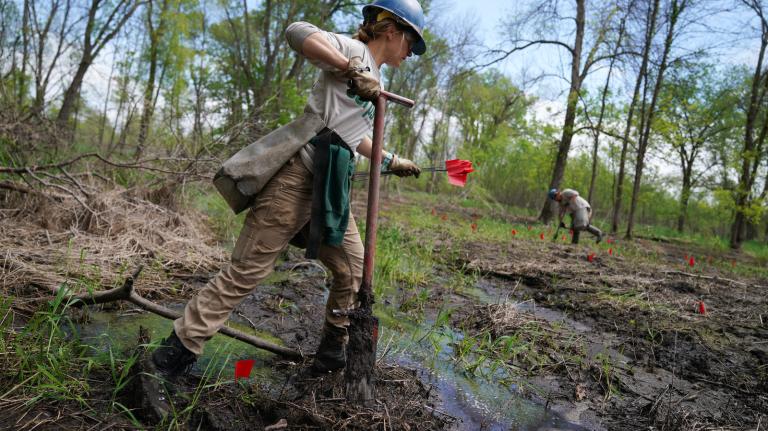This coverage is made possible through a partnership with Grist and Interlochen Public Radio in Northern Michigan.
Wildfires in western and central Canada spread rapidly this week, forcing thousands of people to evacuate, with smoke sweeping into the Midwest and triggering air quality alerts in several states, a reminder of last year’s smoky conditions.
“You looked outside and buildings more than a couple blocks away were starting to look smoky,” said Matt Taraldsen, the supervisory meteorologist at the Minnesota Pollution Control Agency based in St. Paul. “You could definitely see the smoke outside, you could smell it, you could even taste it in the morning. It was really gross.”
Climate change is a major contributor to longer and more frequent wildfire seasons and worsening air pollution due to smoke.
Dry conditions and high winds are driving these fires, following Canada’s warmest winter on record. Some are “zombie fires” that began last season and smoldered underground during the winter, reigniting this spring.
“It is so crispy out there,” said Jennifer Smith, the national warning preparedness meteorologist for the Meteorological Service of Canada.
Last year, Canada saw its worst wildfire season on record; around 45 million acres burned and over 235,000 people were forced to evacuate. This month, Canada rolled out a new marker on its air quality index specifically for wildfires — until now, the scale has been one through 10, but now, there’s a 10-plus, indicating extremely poor air quality.
“We issue this particular advisory when it’s at a 10-plus, and it is due to wildfire smoke,” Smith said. “So it’s really just to emphasize how hazardous the situation is.”
In 2023, parts of the Midwest and Northeast United States saw some of the worst air quality in the world. Taraldsen said checking the air quality index became part of many people’s daily routines.
“They would basically use our forecasts to kind of structure their day, which was unusual,” he said. “There seemed to be a paradigm shift where people were acutely aware that air quality is important, and it can impact your life, and that you can get forecasts for it just like you can for any other weather.”
Improving indoor air quality through purifiers, filtration, and more basic techniques is an important way to address exposure to wildfire smoke — something that’s gaining steam on the federal level as well.
Forecasting air quality can be tricky; it deals with weather, atmospheric chemistry, and human activity. And while the movement of wildfire smoke is difficult to predict, the location of the fires is an important factor.
“Basically all of the air quality impacts we’ve had the past couple of years have been due to remote fires,” Taraldsen said. “Once you pull people out in the fields, it’s hard for them to get back.”
Generally, agencies prioritize responding to fires that threaten human life and infrastructure. Because there are limited resources, those in more remote areas are sometimes left to burn out.
“It’s probably not going to get as many resources as quickly as a city that’s being evacuated, for example,” said Alexandria Jones, the communications manager at the Canadian Interagency Forest Fire Centre, a government agency that coordinates resources like aircraft and firefighters.
Last summer, some of the wildfire smoke that blanketed much of the Midwest and Northeast U.S. came from areas that were hard to reach, according to Alec Kownacki, a meteorologist with Michigan’s Air Quality Division.
“A lot of wildfires that were causing the smoke were in very remote areas to where they couldn’t get any access to,” he said. “So they literally just said, ‘We just have to let it burn out because it’s in the middle of woods. There’s no access roads.’”
In Canada, fires are initially managed by local governments in partnership with provinces and territories. As the intensity ramps up, the interagency center works to manage resources across the country, and sometimes internationally. Last year, Canada brought in 5,500 firefighters from other countries and also sent its own firefighters to Australia — a kind of firefighter exchange.
Indigenous communities disproportionately bear the brunt of wildfires and the smoke they produce. Of the nearly 300 evacuation orders issued in Canada by September 2023, more than 95 were for Indigenous communities — a drastic increase from previous years.
The Assembly of First Nations worked with Indigenous Services Canada to update its fire protection strategy last May, focusing on both wildfires and building fires.
Cindy Woodhouse, National Chief of the Assembly of First Nations said in a 2023 statement that the strategy is a critical step in ensuring the safety and well-being of their communities.
“Every year, First Nations communities experience fires that could have been prevented or mitigated with adequate infrastructure, resources, and support,” Woodhouse said. “Fire services in First Nations communities are frequently faced with insufficient resources and inadequate funding to meet the needs of our populations.”
Last week, the prime minister’s office emphasized millions of dollars in additional funding for wildfire response in its budget.
Jones, with the Canadian Interagency Forest Fire Centre, said most wildfire response is currently going to the provinces of Manitoba, Alberta, and British Columbia.
The government also gave up to $1.2 million Canadian dollars ($881,200) in funding for the center to help with wildfire prevention and mitigation and bolster the FireSmart Canada program, which aims to help people prepare for and prevent wildfires through efforts like removing flammable vegetation around homes.
“Wildfire season likely isn’t going anywhere anytime soon, but there are things people can do to protect their properties and their communities,” she said. “Focusing on the prevention piece is imperative to preparing people and making them more resilient to wildfire.”





